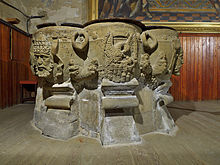Calahorra
| Calahorra parish | ||
|---|---|---|
 Calahorra - Church of the Santuario del Carmen
|
||
| coat of arms | Map of Spain | |

|
|
|
| Basic data | ||
| Autonomous Community : |
|
|
| Comarca : | Calahorra | |
| Coordinates | 42 ° 18 ′ N , 1 ° 57 ′ W | |
| Height : | 358 msnm | |
| Area : | 93.57 km² | |
| Residents : | 24,220 (Jan. 1, 2019) | |
| Population density : | 258.84 inhabitants / km² | |
| Postal code : | 26500 | |
| Municipality number ( INE ): | 26036 | |
| administration | ||
| Website : | Calahorra | |
Calahorra is a historically significant city and municipality ( municipio ) with 24,220 inhabitants (as of January 1, 2019) in the east of the autonomous community of La Rioja in northern Spain . Calahorra is the second largest city in the region and the seat of a bishop ; it is located on a branch of the Camino de Santiago from Zaragoza and Barcelona .
Location and climate
Calahorra is located at a height of approx. 360 m on the north bank of the Río Cidacos and approx. 3 km from its confluence with the Ebro , which at the same time forms the border with the Navarre region ; Logroño , the capital of the La Rioja region, is just under 50 km (driving distance) to the northwest. The climate is temperate to warm; Rain (approx. 545 mm / year) falls over the year.
Population development
| year | 1857 | 1900 | 1950 | 2000 | 2017 |
| Residents | 7.104 | 9,475 | 13,534 | 18,924 | 23,737 |
As a result of the rural exodus as a result of the mechanization of agriculture as well as the abandonment of small farms and the resulting lower need for labor in rural areas, the number of urban residents has increased significantly since the beginning of the 20th century.
economy
Calahorra is a regional center for fruit and vegetable growing; it is also a regional business, craft and service center. Small industry exists in the form of canning and shoe factories.
history
antiquity
In pre-Roman times the place was called Calagurris and was a city of the Vascones . For the first time Calagurris is in the year 186 BC. Mentioned as the site of a battle between the Celtiberians and the Romans . These were won by the Romans commanded by Lucius Manlius Acidinus Fulvianus . During the Roman Civil Wars , the city sided with Quintus Sertorius and helped him against Gnaeus Pompeius Magnus . Pompey has performed it since 76 BC. Successful resistance and could not be taken by Pompey's legate Lucius Afranius until after Sertorius' death (72 BC) , after the trapped inhabitants had suffered from such hunger that it had come to cannibalism and they finally had to surrender . The fall of Calagurris ended the Sertorian War.
From Augustus to the City raised the town belonged to the district Caesar Augusta and was Calagurris Iulia Na (s) sica called to them from the nearby Calagurris Fibularensis (perhaps with today Loarre identical) to distinguish. Under the Roman emperors she had the right to strike coins; thus numerous aces were found with the heads of Augustus and Tiberius . In addition, Augustus had recruited part of his bodyguard from Calagurritani (ancient name of the inhabitants of Calahorra). At the time of the Visigoths , the city owned a mint and had been the seat of a bishop since the 5th century .
middle Ages
In the 8th century, Calahorra was under the rule of the Moors , which initially had little effect on the Christians . However, the Caliph of Cordoba, Abd ar-Rahman III. , around 932, demolish all Christian houses of worship, including the cathedral. In 1045, King García III conquered . of Navarra Calahorra and brought it back under Christian suzerainty.
In the 11th century, Calahorra received a letter of privilege ( fuero ) , which had not been preserved in its original version , which was also valid for the settlements of Funes , Marcilla and Peñalén from 1110 on by the order of King Alfonso I of Aragón and Navarre . Through King Alfonso VII of Castile and León, Calahorra received a new Fuero. The community was headed by a city lord; the most important office in the city council was held by the city judge, who was attested from 1095. The office of the Alcalden (mayor), which can be proven from 1110, was sometimes not clearly delimited from that of the judge.
In the 12th and 13th centuries, Calahorra was affected by the frequent clashes between the kingdoms of Navarre , Aragon and Castile for possession of this area. These differences subsided temporarily when the Castilian heir to the throne Sancho III. At the beginning of 1151 Blanka of Navarre married in Calahorra. Alfonso X of Castile and León granted Calahorra market rights in 1255.
When King Ferdinand IV of Castile-León was still a minor, a controversy arose in Calahorra in 1300 between the nobles Juan Núñez II de Lara and Juan Alfonso de Haro , the former on the side of the Infante Alfonso de la Cerda and the latter stood on that of the Castilian ruler. Juan Alfonso de Haro was able to beat his opponent Lara and arrest him.
In the military feud that Heinrich von Trastámara fought out against his half-brother Peter I , Calahorra joined the former in 1366. Heinrich was proclaimed king in Calahorra. After the soldiers of his half-brother were able to take the town again for a short time, the town was loyal to the House of Trastámara from 1367 until the royal couple Isabella I and Ferdinand II seized power.
Attractions
- The city's first cathedral dates from the time of the Visigoths; the Gothic cathedral with its treasure chamber and its cloister (claustro) was built in the 15th and 16th centuries. The bones of the holy city patrons Emetherius and Chelidonius (sometimes regarded as the sons of Marcellus of Tangier ), who were martyred around 298 AD , are said to rest in the chapel Casa Santa, which was built over a Roman prison Visited thousands of pilgrims. The names of the two saints also appear in the city arms. The facade, created at the end of the 18th century, contains elements of both baroque and classicism . The interior is blocked by an inner choir ( coro and trascoro ) ; In the middle apse, the altarpiece (retablo) created around 1900 attracts attention. The late medieval baptismal font from the previous church is noteworthy.
- Parts of the ruins of the city wall with three towers date from the Arab-Moorish period; the Moors had turned Calahorra into a strong bulwark.
- Other sacred buildings are the Gothic church of San Andrés , the church of the Santuario del Carmen , which was built with echoes of the Mudejar style , and the classical church of Santiago Apóstol .
- A Museo de la Romanización is hidden in a side street; it presents numerous finds from Roman times as well as various display boards.
- The bishop's palace (palacio episcopál) dates from the 17th and 18th centuries . Century with later additions.
- A small tetrapylon (humilladero) from the 16th century on the outskirts marks the location of a cross that was formerly located here and was mainly visited by the Santiago pilgrims.
- Surroundings
- The ruins of a Roman aqueduct can be found 20 km northwest of the city. Furthermore, the remains of a circus and an amphitheater were found.
Famous sons and daughters of the city
- Quintilian (around 35–96), Roman rhetorician (born in Roman Calagurris )
literature
- MI Falcón: Calahorra . In: Lexicon of the Middle Ages (LexMA). Volume 2, Artemis & Winkler, Munich / Zurich 1983, ISBN 3-7608-8902-6 , Sp. 1384-1386.
- Robert Grosse : Calagurris 2). In: The Little Pauly (KlP). Volume 1, Stuttgart 1964, Col. 1011.
Web links
Individual evidence
- ↑ Cifras oficiales de población resultantes de la revisión del Padrón municipal a 1 de enero . Population statistics from the Instituto Nacional de Estadística (population update).
- ↑ Calahorra - climate tables
- ↑ Calahorra - population development
- ↑ Titus Livius 39:21, 8.
- ↑ Strabo 3, 161; Livy, fragment from Book 91 and periochae 93; Appian , Civil Wars 1, 112; Valerius Maximus 7, 6, ext. 3; Florus 2, 10, 9; Orosius 5, 23, et al
- ↑ Pliny the Elder , Naturalis historia 3, 24.
- ^ Suetonius , Augustus 49, 1.
- ↑ MI Falcón: Calahorra . In: Lexicon of the Middle Ages (LexMA). Volume 2, Artemis & Winkler, Munich / Zurich 1983, ISBN 3-7608-8902-6 , Sp. 1384 f.
- ↑ Calahorra - Cathedral
- ↑ Calahorra - Museo de la Romanización
- ↑ Calahorra - Episcopal Palace
- ↑ Calahorra - Humilladero



